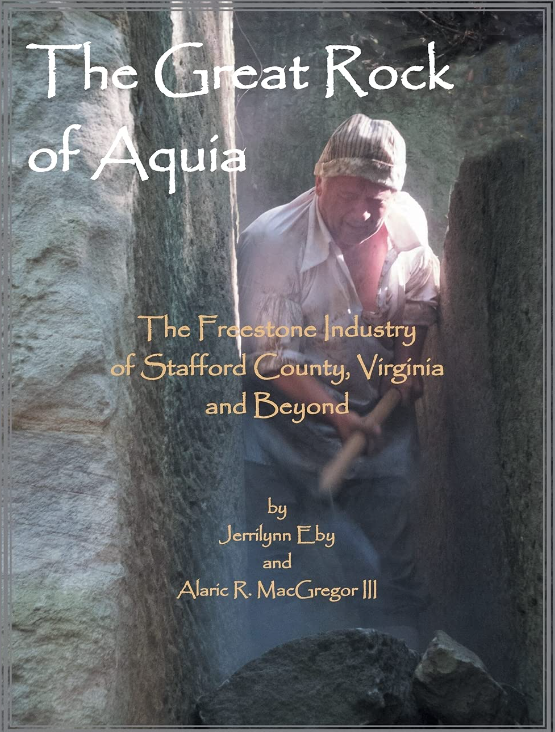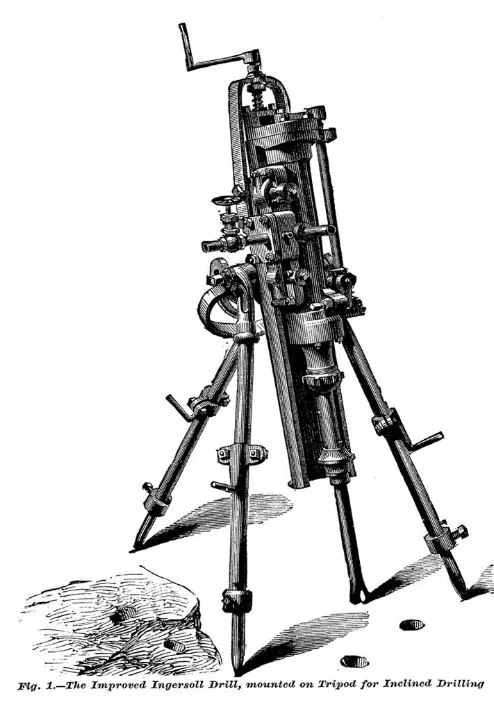
My friend Bob sent me an email recently which said he had found something very special and I should drop over. Driving out to Bob’s is always a pleasure. He lives in the restored, 19th century red sandstone house overlooking the old Seneca Quarry. The house used to belong to the foreman of the quarry and the sandstone blocks which comprise it were deliberately finished in many different patterns so potential buyers could see what options they had. From the yard there is an amazing view of the red sandstone quarry cliffs below, the C&O canal further on, the towpath and finally the magnificent Potomac River.
Bob took me into his large workshop and showed me an iron bar about 52 inches long, weighing about 15 pounds (see above). He suspected it was some kind of star drill which is the tool used to this day to manually dig holes in rock. The way a star drill works is that one man holds the drill (the shaker) and one-two-or-three men pound on it with sledgehammers. The shaker’s job is to turn the drill and remove stone particles from the deepening hole (see below)..

I was dubious. The rod did not have the characteristic star shaped tip of a star drill and I had never seen one with a collar. Below are some star drill examples.

After taking some pictures of the object, I contacted my friends James and Mary Gage who are the world’s experts on early 19th century quarrying tools in New England. A few years ago, they had taken me and my family on a wonderful tour of the Cape Ann, Massachusetts granite quarries. Not only are James and Mary generous with their time but they have a very useful and comprehensive website which I have often referred to in my research, www.stonestructures.org and are authors of The Art of Splitting Stone: Early Rock Quarrying Methods in Pre-Industrial New England 1630-1825.

That James was unable to identify the object, didn’t surprise me because I suspected it was from a machine of the late 19th century and not an early 19th century hand tool. Great progress had been made in the 100 years between 1800 and 1900 in mining and tunnelling; Safety fuses replaced rolled up paper dipped in bacon fat in 1831, dynamite replaced unstable black powder in 1867 and in 1851 more efficient steam drills began to replace the manually driven star drill of John Henry fame. James suggested that the rod might have been repurposed as a large tent peg and noted that it had a “Torx” tip which is found nowadays in some screwdrivers.


I also contacted my friends Jerrilynn Eby and Rick MacGregor from down in Stafford County, Virginia. Not only are Jerrilynn and Rick a warm and wonderful couple, but they were also the world’s leading experts on Aquia Creek sandstone quarries having written, The Great Rock of Aquia. The Freestone Industry of Stafford County, Virginia and Beyond. Aquia Creek sandstone was used to build the White House and much of the capital and they are conversant with all the tools required. Rick has a nice collection of early 19th century quarrying tools, as well. But Jerrilynn not only studies the early 19th century Aqua Creek quarry but is an expert on Iron Manufacturing in her county having written the book Laying the Hoe: A Century of Iron Manufacturing in Stafford County, Virginia.


Jerrilynn presumed that the rod was a drill and guessed that added drill bits fit onto the Torx tip. She also took note of the collar which suggested to her that it was probably used on steam powered hammer drilling machine.

I searched on the internet for a picture of an early steam powered rock drill and found the one below on the left which was produced around 1874 by the Ingersoll company. Notice that enlarged picture of the drill bit on the right does have a collar but does not have a Torx shaped tip.


Next, I wrote to the Granite Museum in Barre Vermont home of the Rock of Ages Quarry, the largest, deepest, active granite quarry in the world. I soon heard from the museum director Scott McLaughlin. He wrote that because of the shape of the tip (Torx and not starred) he did not think it was a star drill but perhaps the leg of a steam drill tripod. He sent me the same picture I have displayed above and upon close examination, I think he is correct! Notice that the tripod leg has collars, and it ends in a Torx shaped tip.

Mystery solved? Perhaps. What do you think?

Leave a Reply